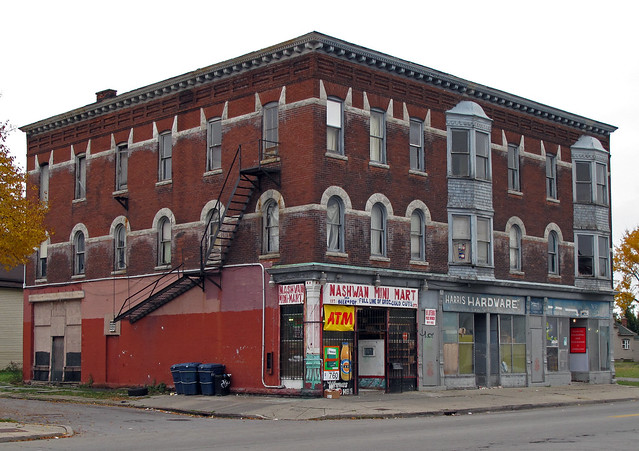On Friday afternoon the Preservation League of New York State placed two significant East Side properties on the Seven to Save list of endangered places - 169 East Ferry and the Willert/AD Price Courts. Here's the League's press release.
169 East Ferry is home to Harris Hardware, Buffalo's oldest black hardware store. Located one block from the recently renovated Performing Arts High School this magnificent building is locally owned by Glenn Banks (see above pic stream). The structure is an important landmark along a street that has seen dozens of mixed-use commercial buildings demolished over the years. It's directly across from this abandoned City-owned building.
The Willert/AD Price Courts were placed on the local radar a year ago via a series of Buffalo Rising posts - here and here - about the threatened sculptural elements at the Courts. These sculptures adorn a uniquely Modernist complex that is home to the first housing project in New York State designed exclusively for African American families.
Western New York Heritage magazine carried this article last Spring about the artists - Robert Cronbach and Harold Ambellan - and the significance of their work. Two of the most compelling Cronbach pieces, flanking the main entrance doors - here - depict an escaped and returning slave.
Buffalo News reporter Mark Sommer wrote this article about yesterday's announcement by the Preservation League.
__________________________________________________________________________
building index • fixBuffalo flickr • creative class • shrinking cities • americansuburbX
spacing toronto • infrastructurist • inhabitat
building index • fixBuffalo flickr • creative class • shrinking cities • americansuburbX
spacing toronto • infrastructurist • inhabitat



7 comments:
Congratulations goes to David Torke. If it weren't for you and your blog, David, no one in the preservation community would have put a spotlight on these important heritage structures!
Chris Hawley, spot on -- you beat me to the punch.
There have been others -- including professors at UB -- who have had their eye on the significance of Willert Park for years (and have used it as a teaching tool), and who played major roles in this preservation effort. But the attention sparked by David's article was the key factor, I believe, in raising this in the public consciousness and setting off a flurry of additional research.
One really cool (IMHO) thing that research brought to light -- but hasn't made it online yet -- is the following:
A very careful 1940 survey of modern architecture in the northeast U.S., carried out by the
Museum of Modern Art, included the Willert Park Courts among its 8 listings for Buffalo. Significantly, the site plan, artwork, and landscaping were all cited among reasons for inclusion -- adding to the importance of preserving this complex intact, rather than just specific elements of it. The MOMA listing notes, “The fan-shaped layout agreeably solves the problem of economical building arrangement on a trapezoid-shaped plot. Trim orderliness avoids military regularity through plan, variation of 2- and 3-story buildings, entries, and planting. Sculptured reliefs in cast stone are colored to harmonize with local brick used for all exteriors.” [Ref: Modern Archiecture, Northeast States, John McAndrew, Ed. (Museum of Modern Art, 1940)]
These notes strongly suggest that the core complex be considered as a cultural landscape worthy of protection. Also, of the eight 1940 MOMA listings in Buffalo, only two (including the Larkin administration Building) have been lost to-date. The significance of this complex is greatly enhanced by this recognition that from the time of its construction, when modern architecture was still a relatively recent phenomenon, it was recognized as a significant part of the nation's modern architecture collection.
Thanks to David for sounding the alarm, giving the community a decent shot at preventing the loss of another of those 1940 MOMA listings.
They would not even have known they exist! Good Job
And this building WOW! Can you get me some more pictures of it for a BRO story?. I have never seen it before. It is spectacular.
The plan innovation of the public housing together with its quality of construction makes it noteworthy and worth saving. There is a subdued and heroic notion to these buildings that would be wise to re-create in new projects. Unfortunately BMHA new builds on Jefferson, at Lakeview and elsewhere shamefully fall short and will be future landfill rather than landmarks.
Irony: 169 E.Ferry is important because it's "the oldest Black-owned hardware store" yet it needs to be saved from that same owner's neglect.
ps - Are the Willert Park apartments still considered to be sufficient housing ?
169 E. Ferry: available for sale by owner. About $100k; use your negotiating skills. Tremendous charm, good things happening nearby. This is a great long term project for someone without huge resources looking to someday develop something.
It's the saddest hardware store in Buffalo. Water stains in the ceiling, old old stock (and little of it), hasn't seen a good washing or coat of paint inside since Nixon. Walk in and you'll feel like it's 1972 in the ghetto. Someone should rescue this
It's better save than destory.
Post a Comment